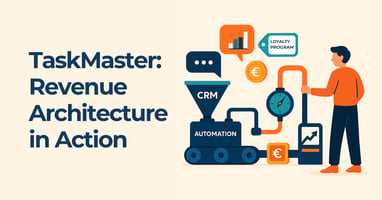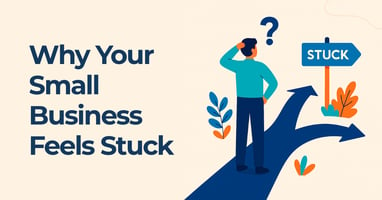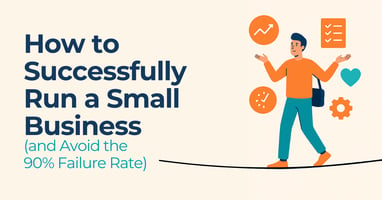Introduction Meet TaskMaster, a fictional software company.
What is a Startup, And When Do You Stop Being One?
Introduction
Are you running a startup or a small business? If you often wonder about this question, let me tell you, you’re not alone.
Many people use these words like they're the same, but they're actually different. They have distinct differences that impact your growth strategy, operational needs, and goals. Knowing what your business is, isn’t semantics. It’s about choosing the right tools, systems, and approaches to scale effectively.
In this article, we’ll shed some light into these distinct terms. You'll learn the difference between startups, small businesses, and beyond. Yes, we’ll cover them all: startup, smallbiz, scaleup…you name it!
You'll also see how a startup grows from one stage to the next. I'm talking about the startup-to-scaleup-to-grownup-to-enterprise growth model.
Plus, you'll find tips on what you can do at each stage to be successful. You will also find metrics to help you understand where your company fits. And actionable insights for success.
One important thing to keep in mind: oftentimes, startups identify as small businesses. And small businesses sometimes position themselves as startups.
For simplicity, we’ll refer to both terms throughout this Ultimate Survival Guide.
Regardless of how you identify, the foundation to be successful remains the same. Having the right tools and strategies in place early on. Let’s not forget that success knows no category!
What Exactly is a Startup?
A startup is often misrepresented as being a new small business. That couldn’t be further from the truth. Other factors set these two business identities apart. Let’s dive into it.
A startup is a young company in the early stages of development. Focused on creating a scalable and repeatable business model. In other terms, a young company that wants to grow very quickly.
These businesses are typically looking to innovate. They are built around a new idea and want to change the way people do things. They try to grow fast, disrupt markets, and get money from investors.
In fact, startups are typically online or technology-oriented businesses. That can easily reach a large market.
Some famous startups are Uber, Airbnb, and Stripe. These companies grew quickly because they found new ways to solve old problems.
How to know you're a startup:
- You earn less than €10 million a year.
- Your team has between 1 and 50 people.
- You're focused on validating your product and growing quickly. You keep testing and improving your product.
- You usually need money from external funding. Such as venture capital, angel investors, crowdfunding, or bootstrapping.
- Your operations are flexible, lean, and rely on informal structures.
- One important thing to mention: not every business recently launched, is a startup.
Common startup problems:
- Finding enough money to grow.
- Making sure people want your product.
- Managing money carefully.
- Building a strong team with a small budget.
- Balancing innovation with operational efficiency.
Before you continue reading on to the next section, explore McKinsey's perspectives. They wrote an article on startup innovation and scaling strategies. Read here "From start-up to centaur: Leadership lessons on scaling.”

What's a Small Business, Then?
A small business is different from a startup. Small businesses usually grow slowly. They serve a local or regional area and have stable income.
In the words of Forbes, “to operate a small business you don’t need a big market to grow into. You just need a market and you need to be able to reach and serve all those within your market in an efficient way.”
Thus, what companies do you think that fall under this category? If you guessed what we know as traditional businesses, you guessed right. Examples include your local bakery, a plumbing service, or a small marketing agency.
How to know you're a small business:
- You also earn less than €10 million a year.
- You have 10 to 50 employees.
- You focus on steady growth, not rapid scaling.
- You're usually self-funded or reliant on traditional loans.
- Your operations are formalized workflows, with defined roles.
In the same way we said not every business recently launched is a startup; we can also affirm not every venture recently launched is a small business.
Common small business problems:
- Limited access to money.
- Competing against bigger companies.
- Balancing customer acquisition and retention.
- Making sure operations are efficient.
- Hiring and retaining skilled employees.
Stages of Startup Growth: From Startup to Scaleup and Beyond
It is said that 90% of startups will fail. What happens to the other 10%?
Well, surviving this daunting failure rate is not always easy. And it also doesn’t grant you a seat on the next stage of the growth model. But it’s certainly a positive first step.
If you manage to survive and grow at the same time, then you need to be aware of what could be ahead of you.
Let’s review all the different stages your business might move through as it grows!
From Startup to Scaleup
Going back to what we discussed above, the startup stage is usually defined by...
- Focusing on product-market fit (making sure people want your product).
- Finding customers.
- Managing cashflow.
If things go well and we manage to jump to the next stage, then we would become what's known as a Scaleup.
Here, a startup has transitioned into a fast-growing company. With a proven business model prepared for exponential growth.
Key Characteristics of Scaleups:
- You start earning between €10M to €50M annually.
- Your team grows to a figure between 50 to 250 people.
- Your business expands quickly, adding new locations or products.
Milestones Signifying the Transition:
- Achieving scalable and repeatable processes.
- Expanding to new markets or regions.
- Developing strong customer retention strategies.
From Scaleup to Grownup
At this stage, companies have achieved stability and a strong market presence. Growth is more predictable, and operations are optimized. You could say then you have entered the Grownup stage.
Key Characteristics of Grownups:
- Your revenue grows to somewhere between €50M to €500M annually.
- You have between 250 to 1,000 employees.
- You focus on operational efficiency and market leadership.
- You have well-defined operations, robust systems, and established leadership structures.
Challenges at this stage:
- Maintaining innovation while managing risk.
- Expanding product lines without losing focus.
- Balancing profitability with growth.
From Grownup to Enterprise
From the grownup stage, businesses may evolve into enterprises. These are large, mature companies with extensive resources. Operations also span national or international markets.
Key Characteristics:
- Your revenue is over €500M annually.
- You have more than 1,000 employees.
- You lead the market and manage operations globally.
- You have formal hierarchies and sophisticated systems.
Challenges at this stage:
- Sustaining growth and market leadership.
- Diversifying product offerings without losing brand identity.
- Navigating complex regulations and compliance issues.
Let’s sum this up…
Key Milestones Across Stages
Stages of Growth for Startups

Stages of Growth for Small Businesses

EU definitions
While the focus of this article has been the Startup and Small Business verticals, we are aware there exist other definitions out there.
Others, like the EU definitions, use a different terminology to refer to each stage. But you will notice the stages are actually very similar to what we just covered. Which is why we won’t be repeating ourselves.

Understanding Your Stage Matters, But Why?
Knowing where you are helps you choose the right tools and goals. Recognizing your business’s stage is about clarity.
By understanding where you are in your growth journey, you can:
- Adopt the right tools. Implement foundational systems like CRMs as early as possible. This supports scalability, taking into consideration your company's size and journey. Knowing that you can evolve your systems as you go.
- Set realistic goals. Align your business objectives with the resources and capabilities of your current stage. For startups, this may mean prioritizing product development. While small businesses might focus on operational efficiency.
- Allocate resources effectively. You need to know the goals you should be pursuing and the metrics you should be measuring. It will give you clarity as to where your resources should go. Is it finding customers, retaining them or both?
- Adapt and iterate. Be open to change and willing to adapt your strategies. Based on market conditions and customer feedback. But, also, based on your own journey as a company. Regularly evaluate your progress and make necessary adjustments. This ensures you're on the right track.
- And, ultimately, prepare for growth. For startups, preparation might mean validating the market fit before scaling. For scaleups, it could mean building strong leadership and expanding strategically.
Remember, the journey from startup to scaleup and beyond is not linear. There will be ups and downs, challenges and successes. By understanding your stage you can adapt your approach accordingly. By adapting, you can set your business up for long-term success.
Here is a great resource to discover what leads startups to successfully scale.
Challenges at Each Stage
- Startup Challenges:
- Finding customers.
- Building a team on a budget.
- High uncertainty and risk.
- Scaleup Challenges
- Coordinating across many teams or locations.
- Retaining a culture of innovation.
- Competing with larger, established firms.
- Securing ongoing investment or managing cash flow.
- Grownup Challenges
- Balancing operational efficiency with continued innovation.
- Avoiding stagnation while optimizing processes and structures.
- Expanding product or service offerings without losing focus.
- Strengthening leadership and succession planning.
- Enterprise Challenges
- Sustaining growth and market leadership.
- Diversifying product offerings without diluting brand identity.
- Navigating complex regulations and compliance issues.
- Managing organizational complexity and fostering employee engagement at scale.
Tips for Navigating Each Stage
- Startups:
- Focus on talking to customers and adapting quickly.
- Keep costs low and experiment with scalable, repeatable business models.
- Scaleups:
- Strengthen the leadership team to manage growth.
- Implement scalable processes for communication, decision-making, and operations.
- Grownups:
- Optimize operations and systems to drive efficiency without losing creativity.
- Refine product offerings based on evolving customer needs.
- Develop long-term strategic partnerships and solidify the company's market position.
- Enterprise
- Invest heavily in innovation and R&D to stay ahead of industry trends.
- Build robust compliance frameworks to navigate complex regulations.
- Foster employee engagement and maintain agility despite organizational size.
Could a Startup Ever Become a Small Business?
Early on we established the key differences between startups and small businesses. We learned that, while many people use both terms equally, they don’t necessarily coexist within the same growth model.
So, could a startup ever become a small business?
Technically, yes. Practically, it’s complicated.
The startup-to-small-business transition is uncommon but not impossible.
While many startups aspire to scale into enterprises, others end up choosing a different path: pivoting toward becoming a small business.
This decision often arises from:
- Market constraints: The market is too small for rapid growth.
- Founders' preferences: Founders prefer a balanced lifestyle over rapid expansion.
- Niche focus: The business focuses on a very specific group of customers.
By pivoting, startups may abandon their initial goals. They went after rapid expansion and market disruption. Now they focus on steady, sustainable growth.

What's Stopping a Startup From Becoming a Small Business?
A startup can pivot into a small business, but only under certain conditions. The key factors are funding structure, founder preferences, and investor expectations.
The Catch: Funding Model
If a startup has raised capital from investors, particularly venture capital, then pivoting becomes tricky.
VCs invest with the expectation of high returns, typically through rapid growth, acquisition, or IPO.
A small business, by definition, doesn’t aim for hypergrowth. It focuses on long-term sustainability and profitability.
If the business slows down intentionally (for lifestyle or niche reasons), it likely won’t provide the 10x+ returns investors expect. In that scenario, the pivot would often be seen as a failure in the eyes of the investor. Even if the business is profitable.
Possible Exceptions (aka when pivoting is possible):
1. Crowdfunded or Bootstrapped StartupsThese founders have more flexibility. They’re not accountable to venture capitalists and can redirect their goals. If the market turns out to be smaller than expected, or if the founders decide to optimize for lifestyle or long-term sustainability, they can shift toward a small business model without friction.
2. Returning Investor MoneyRare, but it has happened. Some startups have returned unspent funds to investors once they realized that scaling wasn’t feasible. They then continue on as small, self-sustaining businesses.
👉 Take a peek at Gumroad’s story by founder Sahil Lavingia, who famously returned most of the VC money he raised and reshaped the business. From becoming a billion-dollar company, to aiming for a lean, profitable operation, focused on sustainability over scale.
3. Strategic Buyout or Founder Buyback
In some cases, founders negotiate to buy back investor shares, often at a discount or loss. The intention behind is to regain full control of the company. This allows them to pivot the business in a new direction, including downsizing to a small business model. While rare and complicated, it’s not unheard of.
So yes, a startup can become a small business. But whether it should (or even can) depends on how it's funded and what promises have been made. For VC-backed startups, a pivot toward small business isn't just a shift in strategy. It’s a fundamental departure from the growth expectations they were built on.
But for bootstrapped or crowdfunded ventures? A shift toward slow, sustainable growth might be not only possible, but wise. Especially if it leads to healthier businesses, happier founders, and longer-term impact.
Conclusion
The path from startup to established business is not a checklist of stages. It's a dynamic evolution shaped by strategic adaptation. By understanding where your business stands, you're embracing the unique opportunities and challenges of each phase. You can proactively navigate the complexities of growth and build a sustainable enterprise that thrives in the long term.
Remember, success isn't just about reaching a destination. It's about continuously evolving and optimizing your journey.
Next Steps:
- Go back to The Ultimate Survival Guide For IT Startups to grow your knowledge on small businesses.
- Share your thoughts in the comments: How do you usually refer to your business? Is it startup, smallbiz, scaleup… or something else?
- Get your free business mini audit now!




